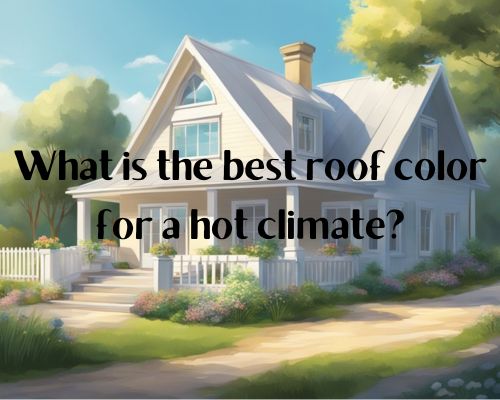
What is the Best Roof Color for a Hot Climate:
Expert Recommendations
Choosing the best roof color for your home in a hot climate is crucial for maintaining comfort and energy efficiency. When temperatures soar, a roof that reflects sunlight rather than absorbing it can make a significant difference.
Star Roofing Contractors highlights that you opt for lighter colors such as white, light gray, or pastel shades, as they reflect more sunlight and help keep your home cooler.

The color of your roof plays a direct role not only in temperature regulation but also in energy expenses. In hot climates, roofs in darker shades tend to absorb heat, which can raise the internal temperature of your home and lead to higher air conditioning costs.
Light-colored roofs, on the other hand, can reduce the amount of heat entering the home, thus lowering energy consumption and contributing to a more sustainable living environment.
For homeowners mindful of aesthetics, these reflective roof colors can still be stylish and match various house designs.
Whether you prefer the sleek modern look of a light grey roof or the classic appeal of a white one, you can enhance the appearance of your home while also benefiting from increased comfort and lower utility bills.
Choosing the Right Roof Color for Hot Climates
When selecting a roof color for hot climates, it’s crucial to consider how different colors can affect your home’s energy efficiency and comfort.
Lighter, reflective colors can significantly reduce heat absorption and lower your cooling costs.
Impact of Color on Energy Efficiency
The color of your roof has a direct impact on your home’s energy efficiency, especially in hot climates.
Lighter colors such as white or light gray have high solar reflectance and thermal emittance properties that help reflect sunlight instead of absorbing it.
This can greatly reduce the heat that enters your home, keeping interior temperatures lower and easing the burden on air conditioning systems.
Cool roofs are specifically designed with reflective materials to maximize energy savings.
These roofs can dramatically improve your home’s energy efficiency by reducing cooling energy costs, making them an excellent choice if you live in a hot climate.
Best Roof Colors for Heat Reduction
For optimal heat reduction, consider using lighter colors like white, beige, or light gray. These colors are the most effective in reflecting sunlight.
Reflective properties in these colors ensure that your roof does not absorb as much heat as darker colors would.
Materials like cool roofing shingles come in a variety of lighter hues and are engineered to reflect more sunlight.
Additionally, some specialized coatings can enhance the solar reflectance of your existing roof, providing an energy-efficient solution without the need for a full roof replacement.
Materials and Maintenance Considerations
In hot climates, choosing the right roofing materials is crucial for energy efficiency and durability.
It’s important to consider materials that can withstand high temperatures and require minimal maintenance. Get to understand more on these materials with Star Roofing Contractors.
Roofing Materials Suited for Hot Climates
Several roofing materials perform well in hot climates, each offering unique benefits.
Metal roofs are highly reflective and durable, reducing the heat island effect. They often have reflective coatings that further enhance their cooling properties.
Clay and concrete tiles are excellent for hot weather as they possess thermal mass, which helps to keep your home cool by absorbing and slowly releasing heat. These materials are also fire-resistant and durable.
Slate roofs provide similar thermal benefits and offer a long lifespan with minimal maintenance, though they tend to be more expensive. Asphalt shingles with cool roof technology can also be considered for their cost-effectiveness and improved energy efficiency.
Maintenance and Durability Factors
Maintenance and durability are key considerations for any roofing system.
Metal roofs require minimal maintenance. However, you should inspect them for rust or corrosion periodically. With proper care, metal roofs can last over 50 years.
Clay and concrete tiles also need minimal maintenance. But, you should check them for cracks or chips that could occur over time. These tiles are durable and often last over 50 years.
Slate roofs are highly durable. They can last over a century. Maintenance involves checking for broken or loose tiles.
Asphalt shingles are easier to install but may need more frequent maintenance compared to other materials. Keep an eye out for curling or missing shingles, especially after extreme weather events. Using cool roof shingles helps in extending their life and reducing maintenance needs.